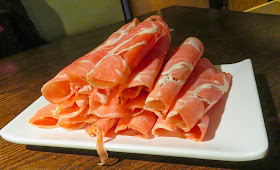Instant-boiled mutton is a Chinese hot pot dish dating back to the Yuan Dynasty. During a battle, Kublai Khan had a craving for stewed mutton. The enemy's troops were approaching, so a chef quickly cut off thin mutton slices and put them in boiling water which were removed as soon as the lamb changed color and put them into a bowl with salt. After the battle, Kublai Khan requested the dish again and gave it its name.
Today, a hot-pot of boiling water is put in the middle of a table with the tail of a lamb, tofu, Chinese cabbage, bean sprouts and vermicelli to prepare the soup base. Paper-thin lamb slices are prepared and put into the boiling hot-pot using chop sticks. The lamb is removed as soon as it changes color. Each person has a small bowl to hold sauce for the cooked lamb which is dipped into it, usually a mixture of sesame sauce, chili oil and leeks.
Shabu-shabu, with origins traced to instant boiled mutton, was introduced in Japan in the 20th century. It is a hotpot dish of thinly sliced meat (beef, pork, lamb, chicken, duck, lobster or crab) and vegetables (Chinese cabbage, chrysanthemum leaves, seaweed, onions, carrots and mushrooms) boiled in water. The raw meat is dipped into the hotpot for just a few seconds. The cooked meat and vegetables are dipped in ponzu or goma (sesame seed) sauce and served with rice. Once all of the meat and vegetables are eaten, the remaining broth is combined with the remaining rice for a soup that is eaten last.
When we visited First Lamb Shabu in Chinatown in Flushing, Queens, New York, we knew none of the above. We were there because of an article by Joe DiStefano called "The Absolute Best Chinese Restaurants in Flushing," published at Grubstreet.com. Speaking of First Lamb Shabu, DiStefano said that the "specialty of the house is rich lamb soup replete with ribs and spine." Without that article, I would never have walked in the place. The outside of the building looked like it was boarded up (which turned out to be the next door tenant) and I thought it was closed.
But we checked the door, and it opened, and we found a long thin walk-way with booths on the right side.
Our Chinese server spoke little English and the whole concept of what we were trying to do was unclear to me. Because of what I'd read, I insisted that we get lamb spine and lamb ribs and she guided us to the thinly sliced lamb and to the vegetables in the menu.
 |
| I'm not sure what the dark vegetable is, and after reading about shabu-shabu, I'm wondering if it was a gelatin to melt into the soup. |
 |
| These are the thin lamb slices we should have retrieved and eaten shortly after inserting them in the broth. |
She brought the pot with the soup broth, a mound of lamb backbone and lamb ribs already in it, and then started up the stove inset into the table and it started to boil relatively quickly.
My favorite part of the meal was the lamb backbone before the pot got too hot. The fatty meat just fell off the bones.
 |
| The darker meat is the from the backbone. The lighter, redder meat, is rib meat. |
 |
| Here is the pot with some vegetables and the backbone meat is falling off the bones. |
I should have tried the lamb ribs then too, but did not realize they were in the bottom of the pot and waited too long and had to fish the rib meat out sans the ribs after it had already over-cooked.
 |
| This lamby broth has rib meat (darker red) and the over-cooked thin lamb (the white lumps). |
 |
| More meat has cooked off of these bones and there are some vegetables on top. |
 |
| A bowl of lamb bones, fished from the boiling broth. |
I put the thin lamb meat in and also let it way over-cook and ate it after it turned into a mass.
The vegetables were put in and cooked for awhile and then eaten by themselves, instead of put in the pot initially and allowed to stay there and flavor the broth.
After awhile, the meat was all too over-cooked. It was still good, just not what it could have been. However, the soup was amazing. Lamby beyond belief. If we lived nearby, I would have taken the broth home to eat later.
I have been thinking about going back and what I would do differently. I have thought I would get double the backbone, which I enjoyed so much, get mushrooms and let it boil in the broth, do away with the thin slices of lamb which got so over-cooked and fish the lamb ribs out much earlier.
Then I read about instant-boiled mutton and shabu-shabu and realized we'd approached it all wrong. Now I am extra desirous to return and get two orders of backbone, one primarily as the base for the soup, and one for early eating, and add mushrooms and vegetables for the broth. We probably should try the thin-sliced lamb as well, but just barely cooked. However, the backbone meat is so nice that I don't think the thinly sliced lamb will measure up to it.





I would definitely replace all those greens with vegetables like mushrooms, broccoli, eggplant, etc. Especially mushrooms. The spine meat was wonderful, but the broth was divine.
ReplyDelete